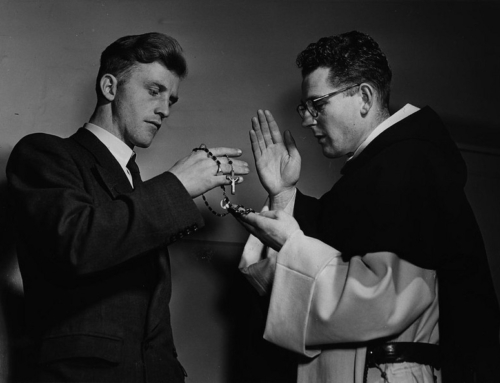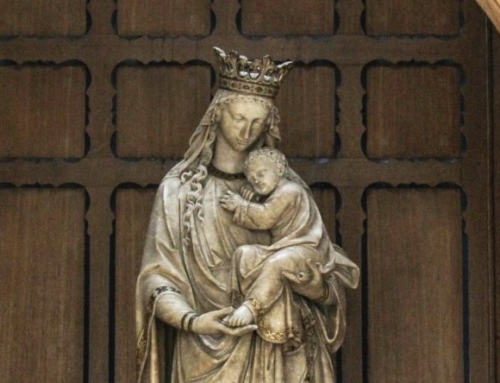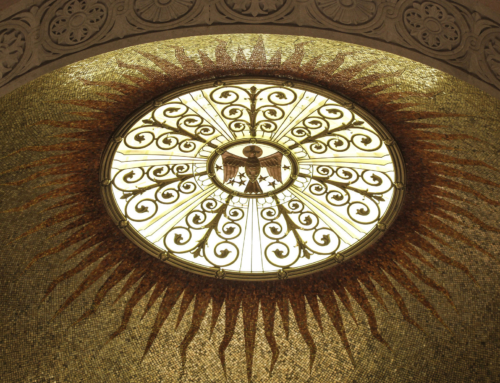Dante Alighieri, the late medieval Italian author of the Commedia, hails King David as the “sovereign singer” (Paradiso, XXV.72) and the “singer of the Holy Spirit” (Paradiso, XX.38). As both king and the inspired author of the Psalms, David, in Dante’s eyes, forged a unity out of many peoples and harmony out of a multiplicity of voices and instruments. Unity and harmony bespeak the City of God.
“It was to serve [God],” St. Augustine writes, “that David made use of music in order to express a tremendous truth by means of mystical symbols, for what can better suggest the unity in variety of a well-ordered city than the harmony produced by the rational and controlled concord of differing tones?” (City of God, XVII.14). The City of God, the heavenly court, finds its order in the unity of its citizens with the will of God; so also the heavenly city resounds with music, with “angels and archangels, with thrones and dominions, and with all the hosts and powers of heaven” (Preface of Sundays in Ordinary Time I), singing “Holy, Holy, Holy!”
Music, as St. Augustine rightly suggests, is a tangible symbol or analogy that eloquently expresses the heavenly life; music introduces order where there was once cacophony. Yet such a perfect order does not arise spontaneously: We must first learn how to make music ourselves and with others. Drawing upon various authors and theologians, I propose here a musical reading of salvation history and of our own participation in this saga of being made ready to take our place in the heavenly choir. Music, in its richness as a symbol, can indeed express God’s saving action in time as well as its culmination in eternity.
*****
In the beginning, there was harmony. J.R.R. Tolkien describes the creation of the universe in his own mythology as a great symphony of primordial spirits, the Ainur, that revealed the original orchestration of the Creator, Ilúvatar:
Then the voices of the Ainur, like unto harps and lutes, and pipes and trumpets, and viols and organs, and like unto countless choirs singing with words, began to fashion the theme of Ilúvatar to a great music; and a sound arose of endless interchanging melodies woven in harmony that passed beyond hearing into the depths and into the heights, and the places of the dwelling of Ilúvatar were filled to overflowing, and the music and the echo of the music went out into the Void, and it was not void. (The Silmarillion, 3–4)
Harmony constituted the universe, wherein the created order crescendoed, ebbed, sped up, and fell silent according to the designs in the mind of the Creator. As Tolkien’s myth captures, each created voice sang, and each hand plucked its instrument in one song of praise to the Lord, never disrupting the rhythm the Creator maintained. What the mind of the first man commanded, his voice brought forth in beautiful clarity. With the creation of another like him, a richer music filled the garden, the complementary low and high interweaving in perfect harmony. Alongside the birds, they gave voice to those without a voice, raising the praises of creation to the Creator.
All who heard the symphony of the whole creation—varied harmonies united in one song—declared it good.
A Sinner Was I Conceived
The man and the woman, however, grew deaf to the whole. They thought that their voices should rise above the others in power and that they could sing themes only they could conceive. Pridefully, these voices discarded their contribution to the interchanging melodies. They, as Melkor, the Ainu who introduced evil in Tolkien’s tale, forfeited their place in the most beautiful song ever sung, the one that transcends the individual voice and can only be sung in union with others.
Straightway discord arose about him, and many that sang nigh him grew despondent, and their thought was disturbed and their music faltered; but some [of the Ainur] began to attune their music to [Melkor’s] rather than to the thought which they had at first. (The Silmarillion, 4)
Dissonance and discord entered into the eternal harmonies that had moved the universe. The song to the Lord was no longer found on the lips of all. Parents ceased to teach their children to listen and sing in harmony or to take up an instrument and pluck its strings with skill. The music, however, did not cease once and for all. Rather, the Creator of the voice and the instrument, of song and music itself, had foreseen such disturbance and would soon bring forth a new beauty even from sorrow. He would take up the “most triumphant notes” of the “clamorous unison as of many trumpets braying upon a few notes” and weave them into a beautiful new melody (The Silmarillion, 5).
The first notes of this melody rang out on earth: “Glory to God in the highest and on earth peace to those on whom his favor rests” (Lk 2:14).
Behold, an announcement from heaven of the birth of a new voice, of one who would grow up learning the songs of the Lord’s harpist from his mother: “Sing to the Lord a new song!” (Ps 96:1). In those quiet years in Nazareth, he learned to magnify the Lord in his human heart.
When Jesus finally left his childhood home and struck out into the world of those whose nature he shared, he heard clamorous voices mocking him, dissonance in the songs emanating from the Temple, discord even among those who followed him. All of these sorrowful sounds he bore in his heart. He carried this cacophony to the Cross and destroyed it in the silence of death.
Three days passed and a new song rang out from within the tomb on the lips of angels: “Alleluia! Alleluia! Alleluia!” The sorrowful sounds of the suffering multitude had been taken up in the loveliest of melodies: the song of the Resurrection. Dissonance and sorrow were no longer dominant themes but were instead woven into the greater symphony. Sorrow now finds its end in joy; dissonance gives way to resolution.
Put a Steadfast Spirit Within Me
Whether opera singers, church choir members, shower soloists, or obliviously tone-deaf, we are all invited into the new song of the Resurrection through our baptism into Christ. Joined to Christ, we are promised the Holy Spirit, the one sent into our hearts to repair and tune them and to direct them in harmony with others. This inner work of transformation finds its pinnacle not in the unaided individualism of a solo performance but in the complete docility of a soul to the movements of the Holy Spirit, which establishes a life-giving harmony with God himself.
Such docility originates from a multiplicity of gifts operating as one in the soul. The virtues, instilled and nurtured by grace, guide our actions to achieve the good. In addition, the Holy Spirit freely bestows his seven-fold Gifts as necessary helps, through which the Spirit himself inspires our actions and moves us toward God. French Dominican Father Ambroise Gardeil expressed the movement of the Spirit within the soul in terms of music.
Thus the Holy Spirit, that Great Performer, from the depth of charity wherein He dwells, sees Himself performing upon the soul which is subject to Him, as upon a keyboard with many stops, here the activities, the infused virtues, there the receptivities, the Gifts. Behold Him, the Divine Orpheus, who sets Himself to the task. “The spirit blows where He wills.” Under His impulse, the keys of the regenerated soul vibrate and there results a divine harmony wherein the vigorous chords of virtues mingle with the intoxicating vibrances of the Gifts. (The Gifts of the Holy Spirit in the Dominican Saints, 29)
The Holy Spirit works within a soul, as an organist plays an organ, to bring the virtues and Gifts into a unified sound so that each person’s life produces a beautiful tone. Yet each tone is different. The Spirit directs each life to produce its particular sound, but also draws all people together to fill heaven and earth with God’s glory, as Tolkien’s Ainur did in their first song. Thus, we exclaim:
O praise him with sound of trumpet,
praise him with lute and harp.
Praise him with timbrel and dance,
praise him with strings and pipes.
O praise him with resounding cymbals,
praise him with clashing of cymbals.
Let everything that lives and that breathes
give praise to the Lord. (Ps 150:3–6)
The Holy Spirit makes music of people’s lives. He is the one who moves within us to produce sonorous thoughts, words, and deeds that give glory to God in the midst of the world. Some he has made to be lutes or harps, by which he brings forth more intricate harmonies; others he has chosen to be cymbals, who execute their simple task and enrich the greater symphony. At distinct moments, God allows a soloist to soar, enlivened from within by the Holy Spirit, to begin a special movement for the glory of God, only then to fall back into the movement of the whole. This is the work of the Holy Spirit: to bring all the Lord’s instruments, in their varying sounds, abilities, and responsibilities, into one harmonious song of praise.
O Lord, Open My Lips
Dante saw the culmination of the unifying work of the Holy Spirit in his journey through Paradise. Paradise is filled with music, which Dante tries to capture in his own cantos, but all the while warning that no worldly words can adequately capture the heavenly harmonies. He hears Ave Maria and many Hosannas—even St. Thomas Aquinas, the great Eucharistic hymn writer, approaches Dante singing.
Perhaps the most striking moment of harmony is the magnificent formation of an eagle by many souls. Although many individuals, it moves and sings as one. Dante describes his heavenly vision thus:
And what I am now summoned to portray
no ink’s been known to write, or voice to speak,
or any fantasy to comprehend,
For I heard and I saw the Eagle’s beak
express itself in words like “I” and “mine”
when “we” and “ours” were in its mind’s intent. . . .
As flames of many built-up embers send
one warmth, one light, so came one sound alone
from all the many loves that image penned.
(Paradiso, XIX.7–12, 19–21)
Each soul in the eagle shone like a “little ruby” (XIX.4), lit by the Sun into which the souls gaze as only an eagle can do. Illumined by the one vision of the eternal light, with “flames kindled by the Holy Ghost” (XIX.100), the souls of the just come together in one magnificent song of praise.
So did I see that symbol sewn with praise
of grace divine a-ruffling with the sound
of songs they know in heaven who rejoice.
(Paradiso, XIX.37–39)
Yet such a sight was only the beginning of even greater harmonies. The archangel Gabriel, in the presence of Mary, began to lead the entire heavenly chorus in the song he descended from heaven to sing: “Ave, Maria, gratia plena.”
The blessed court responded to his song,
singing the antiphon on every side,
and radiant peace shone forth in every face.
(Paradiso, XXXII.97–99)
Grace had passed into glory in this heavenly choir. United in one song, the whole multitude turned to the Source of light and harmony through the intercession of the Mother of God. With souls recreated by the grace of the Holy Spirit and glorified by the vision of God, the multitude brought forth a beautiful symphony in perfect harmony due to “the Love that moves the sun and the other stars” (Paradiso, XXXIII.145).
*****
Music, we can say, beautifully expresses the whole sweep of salvation history—from original harmony to the introduction of discord to Jesus’ new song of salvation—and our own part within that story: As music touches the depths of the soul, so does the Holy Spirit recreate us in the image of Christ in order to live as one in his Body. Made in view of our participation in the heavenly choir, we are formed by the Holy Spirit as instruments of praise during our earthly sojourn. The sorrows and sinfulness of this earthly life are gradually transformed and intertwined into the greater movement of salvation. Through forgiveness and the creative work of the Holy Spirit, the dissonance of our lives finds its resolution in a life of praise. With the Holy Spirit interceding for us and within us (Rom 8), we look forward to the glorious day when we too may join the saints and angels and the Blessed Virgin Mary in one chorus of praise of our heavenly Father.
✠
Download a PDF of this article here



